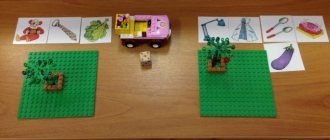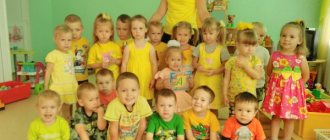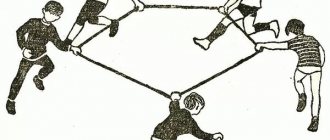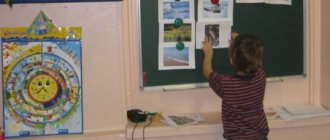Planning educational activities in the preparatory group
Maria Melnikova
Planning educational activities in the preparatory group
Topic of the week: Imagine for a moment how we would live without books
Goal: Generating interest in books. Draw attention to illustrated editions of familiar works
Tasks:
1. Educational: Develop interest in fiction and educational literature, develop the ability to feel the beauty and expressiveness of the language of a work, sensitivity to the poetic word. Develop the ability to explain the main differences between literary genres.
2. Developmental: Develop the ability to listen carefully to works, the ability to cherish and care for books.
3. Educational: to cultivate responsiveness and respect for books in children.
“My Favorite Fairy Tale” together with parents
PLANNING EDUCATIONAL WORK
Monday 03.12.2017
Joint activities of adults and children Independent activities of children Interaction with families
Organized educational activities Educational activities in special situations
The first half of the day-
-Games based on interests;
-Mosaics, puzzles for the development of hand motor skills;
-Pencils, paper, stencils - exercises in drawing circles and squares. Looking at books at the book center. Enter the d/i “Which fairy tale is the hero from?”
(playing field, chips, cube)
Walk: Independent motor activity Purpose : teaching children to independently organize games, find activities of interest.
Games with external materials: bird food, shovels,
Afternoon -
Board-printed games
Goal: encouraging children’s desire to master the rules of the simplest printed board games, teaching them to obey the rules in the game. Place the works of V. Dragunsky in the book corner. Add coloring pages of fairy-tale characters to the art corner.
d/i “Whose traces?”
(animal cards, footprint cards)
Invite parents, together with their children, to make a book with their own hands “My Favorite Fairy Tale”
1. Cognition. Formation of a holistic picture of the world. (Natural environment. Environmental education.)
Dybina, p. 35
Topic: “Journey into the past of books”
Purpose: the formation of children's knowledge of how a book was transformed under the influence of man.
1. Objectives: To acquaint children with the history of the creation and production of a book, with its development.
2. Activate cognitive activity ;
3. arouse interest in the world of books; to human creative activity ;
4. Foster a caring attitude towards books. Subject-practical environment: colorfully designed books, illustrations depicting printing presses from different times; a set of pictures on the theme from the past to the present of the book; a set of plot pictures reflecting a careful attitude towards books.
Approximate activity plan : 1. Motivational and incentive: viewing the exhibition of books.
2.Basic: direct occupation, physical. just a minute.
3. Reflective: What interesting things did you learn?
2. Musical activity (according to the plan of the music worker)
3 Physical education (according to the physical instructor’s plan )
The first half of the day-
-morning exercises (consolidating the ability to walk and run in all directions, consolidating the ability to catch a ball, repeating crawling on a gymnastic bench, exercising in maintaining stable balance) Work together with physical. instructor.
Repetition of songs: “Our Motherland is strong”
- together with music. leader.
B Conversation: “My favorite book”
Goal: fostering a love of books. Consolidate the idea of the work of a writer and artist, cultivate a caring attitude towards books.
D/i: “Which fairy tale is the hero from?”
.
I/r: Repeat the sequence of winter months and the names of the days of the week
Walk:
Forming in a column of 2 (repetition of physical education class)
Observing the weather. Purpose: to clarify and concretize the idea of winter (the shortest days, the longest nights, a lot of snow, varied precipitation, trees standing bare, etc.), to teach to establish the dependence of the life of plants and animals on changes in inanimate nature.
Outdoor games: “Don’t stay in the snow”
Labor: Rake snow under trees and flower beds.
I/R: Hit the target with a snowball.
Independent games for children.
Afternoon -
Gymnastics after sleep “Bicycle”
(see card index, card No. 2"
Reading fiction:
V. Dragunsky “The Enchanted Letter”
.Goal: developing the ability to answer the teacher’s questions about the content of the work.
D/i “Whose traces?”
Problem situation “What will you do when you are alone at home and the doorbell rings?”
. Target. Warning children against contact with strangers.
I/R: repeat counting up to 10 in forward and reverse order
Cor/r on the recommendation of a speech therapist: a selection of pure sayings for the pronunciation of the sound sh
Circle "Krasnoyarsk Territory - Small Motherland"
"Minerals of the Krasnoyarsk Territory"
Goal: Continuation of the formation of ideas about minerals and methods of their extraction in the Krasnoyarsk Territory.
(Coal, oil, gas)
.
Working with mineral samples ."
Tuesday 04.12.2017
Joint activities of adults and children Independent activities of children Interaction with families
Organized educational activities Educational activities at scheduled times First half of the day -
Entering into
books about the flora and fauna of the Krasnoyarsk region
Games in a corner of nature with natural materials: pebbles, shells, cones;
— -Games based on interests
-Mosaics, puzzles for the development of hand motor skills. D/and ball
Walk: Creating conditions for physical activity.
Games with external materials: bird food, shovels, buckets, balls.
Afternoon -
Role-playing game “Let’s go on a hike”
— Activating knowledge about the nature of the native land, teaching basic tourism skills, inventing and introducing new situations. (caps, backpacks, map, compass, fabric for creating a cave, flashlight, first aid kit)
Board-printed games
Goal: to encourage children to master the rules of the simplest printed board games, to teach them to obey the rules in the game. Place books and portraits of poets in the book corner. In the art corner, add coloring pages for the characters “The Wizard of Oz”
d/i "The fourth odd one"
(a set of cards, each card
shows 4 objects , 3 objects are connected by a common feature, and 4 is extra)
Consultation for parents on traffic rules on the topic: “Everyone is supposed to know the traffic rules!”
1. Cognition (FEMP)
Lesson 7
Topic: “Introduction to the designation of the number 10”
, Pomoraeva p. 41
Goal: Clarification and understanding of the number 10 Objectives: continue to learn how to form the number 10 from ones. Strengthen counting skills within 10 forward and backward . Give an idea of a polygon using the example of a triangle and a quadrilateral. Strengthen the ability to navigate in space using symbols, determine the direction of movement of objects, reflect their spatial position in speech. Subject-practical environment: ball, envelopes with tasks, cards with numbers from 1 to 10, cards with images of different numbers of objects (up to 10 , triangles, quadrangles, magnetic board, pictures with the image of a Lumberjack made up of different polygons, Ellie doll.
Environment of interaction: teacher-child. Approximate activity plan : 1. Motivational and incentive: the appearance of the Ellie doll, game exercise “Let's help the Ellie doll return home”
2.Basic: direct physical education lesson
3. Reflective: What did we do today? What new did you learn? What did you like?
2. Physical education (according to the plan of the physical instructor)
3. Cognition (design, manual labor)
Topic: Bookmark for a book
(see folder)
Purpose: Making a bookmark using the origami technique with appliqué elements.
Objectives: Teach children to make bookmarks for books with their own hands. Develop fine motor skills, eye, interest in your work, imagination, aesthetic taste. Improve your skills and abilities.
Subject-practical environment: colored paper, scissors, glue
Planned result : Making bookmarks
Environment of interaction: teacher-child. Approximate activity plan : 1. Motivational and incentive: showing the technique of making a book.
2.Basic: direct occupation, physical. Just a minute, getting the job done.
3. Reflective: looking at crafts, what you liked First half of the day
Morning exercises (reinforcement in walking and running, stopping at the teacher’s signal, crawling on your stomach on a gymnastic bench, developing strength and agility, repeating the task of maintaining stable balance)
Conversation: “What is a book, Where do books live?”
Goal: fostering love and respect for books, developing interest, the need for reading, raising a literate reader who knows the rules of behavior in the library.
D/i “Guess the fairy-tale hero from the description”
Repeating the song: “Our Motherland is strong”
I/r: Compiling cut-out pictures.
Cor/R: on the recommendation of a psychologist Finger gymnastics “Fish”
Walk:
Forming from a column one at a time, into a column 2 at a time (repetition of a physical education lesson)
Observing the work of a janitor. Goal: improving vocabulary; the formation of a desire for order and cleanliness; instill a love of nature, a thrifty and caring attitude towards the environment
Labor: Clear the area of snow, feed the birds
P/n: “What do we like in winter”
,
"Throw and Catch"
.
I/r: drawing geometric shapes in the snow.
Independent games for children.
Afternoon -
walking on massage mats, doing gymnastics after sleep (Kitten)
.
(see card index, card No. 3)
Reading fiction: at the request of the children
D\i: “The fourth wheel”
development of observation, visual memory, introduction to various memorization techniques.
Dance Movement: "Variable Step"
I/r: classification of objects by shape.
Circle "Magic Thread"
Sewing corners using isothread technique.
Goal: to develop the concept of modeling on a plane, to introduce stitching corners using the isothread technique
Wednesday 05.12.2017
Joint activities of adults and children Independent activities of children Interaction with families
Organized educational activities Educational activities at scheduled times First half of the day -
Inclusion in the book center of books and encyclopedias about the animal world, works by D. N. Mamin-Sibiryak.
Games in a corner of nature with natural materials: pebbles, shells, cones, different types of paper.
— -Games based on interests
-Mosaics, puzzles for the development of hand motor skills.
D/and ball
Afternoon -
Board-printed games
Goal: to encourage children to master the rules of the simplest printed board games, to teach them to obey the rules in the game. Place fairy tales from different nations in the book corner. In the art corner add coloring pages of animals from fairy tales
d/i “Give me a word”
(animal cards)
Individual conversations and consultations at the request of parents.
1. Communication ( Preparing for Literacy )
Topic: Sound analysis of words. Varentsova, p. 77. Lesson 4. Goal: developing the ability to conduct sound analysis of words and qualitatively characterize sounds. Objectives: master the ability to isolate a stressed sound in a word. To consolidate the idea of the meaning-distinguishing role of sound. Development of the ability to correlate words consisting of 3, 4, 5 sounds with given patterns. Learning the ability to draw graphic lines in the working line space. Planned result : distinguish between hard and soft sounds. Conduct a sound analysis of words. Subject-practical environment: five-sound word scheme, red, blue, green chips, pictures of a train with three cars, pencils, workbooks.
Environment of interaction: teacher-child.
Approximate activity plan : 1. Motivational and incentive: game “load the food on the train”
2.Basic: Conversation, what our speech consists of, sound analysis of the word “ruler”
3. Reflective: What new did you learn today? What did you like?
2. Artistic creativity.
Drawing
Topic: "Gray neck"
. Illustration for the fairy tale by D. N. Mamin-Sibiryak. Komarova, p. 52.
Goal: developing interest in creating illustrations for a literary work.
Objectives: To develop the ability to choose an episode that one would like to convey in a drawing, to create images of a fairy tale . Strengthen the techniques of painting with paints, painting over a picture with a brush, using a simple pencil in drawing complex figures. Planned result : drawings based on fairy tale episodes
Subject-practical environment illustration for the work “The Gray Neck”
, landscape sheet, watercolor paints, brushes, jars of water. Interaction environment: teacher-child.
Approximate activity plan :
1. Motivational and incentive: remember the fairy tale “Grey Neck”, consider a toy duck
2.Basic: the teacher demonstrates drawing techniques, children work independently.
3. Reflective: These are the drawings we got. Presentation of your drawings
The first half of the day-
-morning exercises: strengthen walking and running between objects, learn jumping with a short rope, practice rolling hoops (Together with a physical instructor)
Conversation: “Caution, ice”
Goal: to develop children’s knowledge of the basic rules of moving on slippery surfaces, to develop the skills of a careful and prudent attitude towards their health. Form ideas about potentially dangerous situations for a person, teach them to avoid them.
D/I “Guess by the description”
Repetition of songs:
“About Dad”
, dance movements together with music. leader.
I/r: practice shading, teach how to maintain order and cleanliness.
Walk:
Forming from a column one at a time, into a column 2 at a time (repetition of a physical education lesson)
Observing cars passing by the kindergarten. Purpose: Drawing children's attention to the road with passing cars. Find out from children what cars they know (truck, car, bus)
.
Disassemble the car piece by piece (wheel, steering wheel, body)
. What color was the car driving by? Strengthen knowledge about transport.
P/I "Sankey"
,
"Throw and Catch"
.
Labor - Maintaining cleanliness in the area.
I/r: learn to act and navigate according to a signal, in space, develop dexterity.
Independent games for children
Cor/R: on the recommendation of a speech therapist: a selection of pure sayings for the pronunciation of the sound C
Afternoon -
walking on massage mats, breathing exercise “Angry Dog”
(see card index on breathing exercises exercise 5)
Reading fairy tales of the peoples of the Krasnoyarsk Territory “Blueberry”
(Nenets fairy tale)
D/I “Give me a word”
I/r: folding paper like an accordion
Thursday 06.12.2017
Joint activities of adults and children Independent activities of children Interaction with families
Organized educational activities Educational activities at scheduled times First half of the day -
Entering encyclopedias into the book center. Games of different nations”, “Mysteries of the peoples of Siberia”
,
"Proverbs, sayings"
.
Games in a corner of nature with natural materials: pebbles, shells, cones;
— -Games based on interests
-Mosaics, puzzles for the development of hand motor skills.
D/i “Guess the Fairy Tale” (plot field, summary cards)
Games with external material.
Afternoon -
Role-playing game “Bookstore”
Goal: To consolidate children’s understanding of the specifics of the sales profession and its features;
Continue to teach children to assign roles and act according to the role they have assumed,
develop the plot; Learn to model game dialogue. (Racks, books, cash register, telephone, computer, walkie-talkie, badges, money, packages.)
Bring albums of folk crafts and coloring books to the book center
d/i “Folk Crafts”
(6 fields, 48 cards)
Consultation for parents “The book is our best friend”
Cognition (FEMP)
Topic:
“Continuing acquaintance with numbers from 1 to 9.”
Pomaraeva, p. 44 lesson 8.
Goal: continued familiarity with numbers from 1 to 9.
The tasks are to teach how to form the number 3 from two smaller numbers and decompose it into two smaller numbers. Reinforce the idea of the seasons and months of autumn. Clarify the idea of a polygon, develop the ability to find its sides, angles and vertices.
Subject-practical environment: cards with numbers from 1 to 9, pictures of a fox, a cat made from counting sticks, a model of the seasons, a picture of a fox made up of polygons (see tangram game)
Environment of interaction: teacher-child.
Approximate activity plan : 1. Motivational and incentive: the appearance of the cat Basilio and the fox Alice, Game situation “Make a number”
2. Basic: work with handouts, D/I make up a whole part of it, physical education minute 3. Reflective: What did we do today? What new did you learn? What did you like?
2. Artistic creativity. -dimensional applique “Moidodyr”
(see folder)
Purpose: to expand children’s ideas about fairy-tale characters. Objectives: To improve children’s ability to create a composition from individual parts. Strengthen the ability to cut off a part of a cotton pad along a straight and rounded line by eye and according to markings, make small cuts and cutouts. Strengthen the techniques of gluing fibrous materials onto the background of the applique.
Subject-practical environment: thick cardboard purple (blue)
colors, size, A4;
Moidodyr template, cotton pads; colored paper; scissors; a simple pencil; glue ; brush; oilcloth; a cloth to remove excess glue; illustration depicting Moidodyr
Planned result : three-dimensional application Medium of interaction: teacher-child. Approximate activity plan : 1. Motivational and incentive: The appearance of a grimy boy, looking at illustrations from a fairy tale 2. Basic: Physical. a minute, showing how the work is being done, children’s independent work 3. Reflective: What wonderful work you did. An exhibition of works is being organized. Morning
Gymnastics: practice running between objects, learn the game “homeless hare”
, repeat game exercises with the ball.
(together with a physical instructor)
Conversation: “Poetry Day”
Goal: tell children that World Poetry Day is celebrated in March, invite them to remember and recite poems that each child likes. Continue to explain, based on the works you have read, the genre features of the poems. Read passages with the most vivid, memorable descriptions, comparisons, epithets, learn to listen to the rhythm and melody of a poetic text.
D/i “Guess the Fairy Tale”
.
Repetition of songs “Emelina Week”
Our Motherland is strong." Together with the music director
I/r: development of the ability to cut out a rectangle-oval with scissors.
Cor/r on the recommendation of a psychologist
Throwing a ball at each other with any question “about you”
Walk: Formation from a column one by one, in a column by 2 (repetition of a physical education lesson)
Observation of snow. Purpose: Consolidating children's knowledge about natural phenomena;
forming an idea of winter. Labor: offer to clear the table and benches of snow P/i: Shaggy dog”, “At the bear in the forest”
A/r: Practice the ability to step over obstacles.
Independent activity .
Afternoon -
Gymnastics after sleep;
Reading. How old Toka reconciled the Evenki (Evenki fairy tale)
D/I
“Folk Crafts”
Repetition of dance movements: “Kindness”
-I/r: constructing a paper cone
Cor/r on the recommendation of a speech therapist. Insert simple prepositions in speech: on - with, in - from, by.
Circle "Krasnoyarsk Territory - Small Motherland"
Waters of the Krasnoyarsk Territory. Purpose: Acquaintance with the main rivers and lakes of the Krasnoyarsk Territory. The importance of rivers and reservoirs in people's lives. Virtual excursions to bodies of water
Friday 07.12.2017
Joint activities of adults and children Independent activities of children Interaction with families
1. Communication (speech development, reading fiction)
Gerbova 34
“Turning Tales”
Goal: Development of coherent speech, memory, attention, thinking, imagination .
Objectives: To introduce children to folk and original fables; arouse the desire to come up with your own, update, systematize and supplement children’s ideas about the genre of fables, introduce them to the techniques of creating word combinations - fables, stories and fairy tales in this genre, develop a sense of humor, imagination , fantasy, coherent speech.
Planned result : made up of fables Subject-practical environment: toy artist Toropyzhkin, unfinished drawings, drawings - fables, object pictures, animal models, a bag, sheets of paper, colored pencils, a multi-colored flower.
Environment of interaction between teacher and child, child and child.
Approximate activity plan :
1. Motivational and incentive: meeting the artist Toropyzhkin
2.Basic: direct lesson, physical exercise
3. Reflective: What did you like today?
2. Artistic creativity Drawing by Lykov 168 “Golden Cockerel”
Goal: the formation of artistic and aesthetic abilities in children of the preparatory group for school . Tasks: Create an image of a cockerel - a golden comb, using colored pencils and wax crayons. Strengthen the ability to hold a pencil correctly, apply shading, create a background, and draw contour lines. Develop a sense of composition and color, creative imagination, imagination , visual memory. To cultivate interest in the knowledge of fiction and the reflection of impressions in visual creativity .
Planned result : drawings of the Golden Cockerel.
Subject-practical environment: sheet of paper, simple pencil, colored pencils, wax crayons Interaction environment: teacher-child. Approximate activity plan :
1Motivational and incentive: looking at illustrations of the golden cockerel. 2.Basic: teacher showing drawing techniques, children’s independent work.
3. Reflective: These are the drawings we got. Presentation of your drawings.
3. Physical education (according to the plan of the physical instructor)
The first half of the day-
-morning exercises; Exercise children in running at speed, repeat jumping, practice throwing bags into the distance. (together with physical instructor)
articulatory gymnastics “Singing vowel sounds”
;
Conversation: “What kinds of books are there?”
.Goal: development of sustainable interest in the book, its design, illustrations.
Enrich children's understanding of the variety of books and genres of works.
Reinforce the rules of cultural handling of books .
— D/I “as it was before, and as it is now”
Goal: develop attention.
Repetition of songs: “About Dad”
, dance movements together with music. leader.
I/r: Drawing by cells.
Cor/r, on the recommendation of a speech therapist, a selection of pure sayings for the pronunciation of the sound L
Walk: line up in 2 columns in pairs.
Observation of snowflakes. Purpose: To introduce children to the beauty of nature, to show that falling snowflakes can be seen against a dark background
Labor: Feed the birds. Clear the area of snow and twigs.
P/n: “Birds are not big”
,
“Rooster, hen, chicken”
I/r: learn to unbutton boots after a walk.
Independent games for children
Afternoon -
-Gymnastics after sleep;
Reading: Fairy Tale Quiz
Conversation: “The pavement is for cars, the sidewalk is for pedestrians. Goal: to develop children’s understanding of traffic rules
D.I: “How to cross the road?”
A/R: D/I on the recommendation of a psychologist “Guess the time of year”
Circle "Magic Thread"
Sewing corners using the
isothread
.
Goal: to develop the concept of modeling on a plane, to introduce stitching corners using the isothread
The first half of the day-
-Introducing books about fables, fairy tales with illustrations into the book center. A selection of illustrations with a cockerel
Games in a corner of nature with natural materials, figures of insects and animals;
D/I Photos. What books and printing houses were like before and now.
Walk: Creating conditions for physical activity.
Games with external material.
Afternoon -
D/I “How to cross the road?”
models of road signs, playing field
“Village Street”
, cord, planar
“zebra”
, pictures - tasks
“Determine the sequence of transition”
D/I (Flower with multi-colored petals, removable flowers with various Velcro cards depicting objects , phenomena, parts of words , sounds, etc., removable circles divided into 2 or 4 parts with a task, arrow.) Recommend to every family: organize family reading evenings; sign up for the library
Experimenting and experiences while walking in winter
Preschool age is characterized by a special interest in the world around us. Often, a child cannot notice some fundamental things on his own, so it is important for a teacher to teach him not only to look, but also to see. Theoretical knowledge should be supported by visual material and experiments that can enrich children’s knowledge.
Experimentation on walks is divided into two types:
- Frontal - when children have several objects to observe and compare independently. For this type of observation, it is recommended to have two teachers monitoring the students, especially if the group is large.
- Demonstration - the teacher holds in his hands the object that has been selected for teaching. The teacher demonstrates the object and conducts an educational conversation. This method dampens initiative and activity; as a rule, preschoolers are not very interested in activities in which they must only observe without participating.
How to develop self-confidence and leadership qualities in a child
Important! Experiments that will be conducted with children must be selected in accordance with their development and age.
Experiments for preschoolers are not entertainment, but a way of teaching children, their acquaintance with the environment and life. Such walks can be done in the format of an open lesson, with the invitation of parents.







